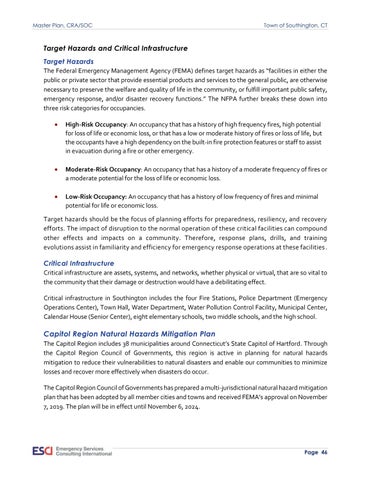Master Plan, CRA/SOC
Town of Southington, CT
Target Hazards and Critical Infrastructure Target Hazards The Federal Emergency Management Agency (FEMA) defines target hazards as “facilities in either the public or private sector that provide essential products and services to the general public, are otherwise necessary to preserve the welfare and quality of life in the community, or fulfill important public safety, emergency response, and/or disaster recovery functions.” The NFPA further breaks these down into three risk categories for occupancies. •
High-Risk Occupancy: An occupancy that has a history of high frequency fires, high potential for loss of life or economic loss, or that has a low or moderate history of fires or loss of life, but the occupants have a high dependency on the built-in fire protection features or staff to assist in evacuation during a fire or other emergency.
•
Moderate-Risk Occupancy: An occupancy that has a history of a moderate frequency of fires or a moderate potential for the loss of life or economic loss.
•
Low-Risk Occupancy: An occupancy that has a history of low frequency of fires and minimal potential for life or economic loss.
Target hazards should be the focus of planning efforts for preparedness, resiliency, and recovery efforts. The impact of disruption to the normal operation of these critical facilities can compound other effects and impacts on a community. Therefore, response plans, drills, and training evolutions assist in familiarity and efficiency for emergency response operations at these facilities . Critical Infrastructure Critical infrastructure are assets, systems, and networks, whether physical or virtual, that are so vital to the community that their damage or destruction would have a debilitating effect. Critical infrastructure in Southington includes the four Fire Stations, Police Department (Emergency Operations Center), Town Hall, Water Department, Water Pollution Control Facility, Municipal Center, Calendar House (Senior Center), eight elementary schools, two middle schools, and the high school.
Capitol Region Natural Hazards Mitigation Plan The Capitol Region includes 38 municipalities around Connecticut’s State Capitol of Hartford. Through the Capitol Region Council of Governments, this region is active in planning for natural hazards mitigation to reduce their vulnerabilities to natural disasters and enable our communities to minimize losses and recover more effectively when disasters do occur. The Capitol Region Council of Governments has prepared a multi-jurisdictional natural hazard mitigation plan that has been adopted by all member cities and towns and received FEMA’s approval on November 7, 2019. The plan will be in effect until November 6, 2024.
Page 46












